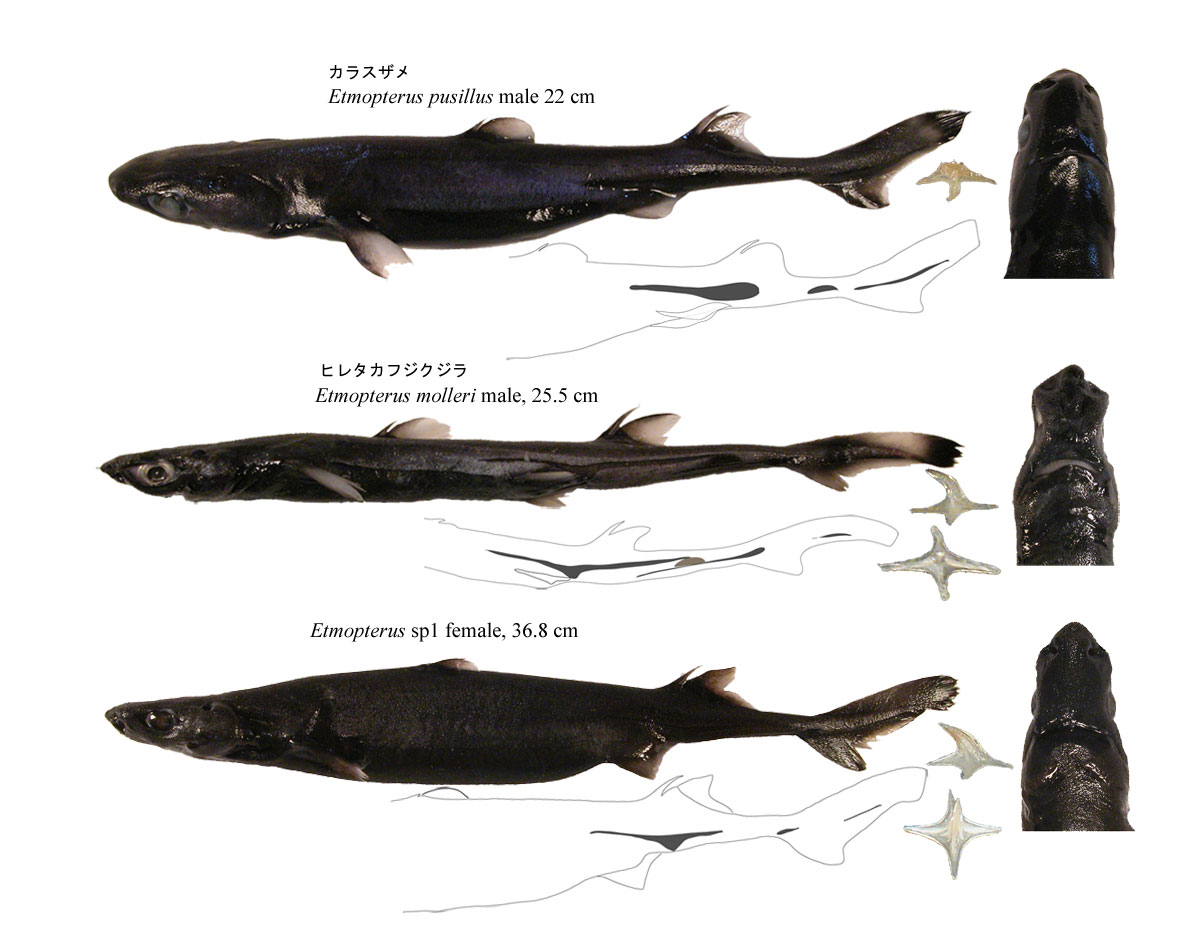| More than 40 species of the genus Etomopterus live in the world and seven of it, Etmopterus brachyurus Smith and Radcliffe, 1902, E. lucifer (Jordan and Snider, 1902), E. molleri (Whitley, 1939), E. princeps Collett, 1904, E. pucillus (Lowe, 1839),E. splendidus Yano, 1988,and E. unicolor (Engelhardt, 1912)1)live in the sea off Japan. Except for E. princeps they live in the upper part of the mesopelagic zone (200-500 m) .Juvenile Miroscyllium sheikoi (Dolganov, 1986) is known to have the lower teeth, similar to those of etmopterids2).Among various extant etmopterids, I prepared the teeth of the two abundant species of Tokyo bay E. molleri and Etmopterus sp 1,and one of the abundant species of Sagami bay E. pucillus and compared them to the teeth of fossil etmoptrids found from the Miocene Haratashino Formation, Gunma prefecture. |
| Recent E. molleri and E. pucillus have "long type lower teeth", while Etmopterus sp 1 has relatively short type lower teeth. All these three species have similar upper teeth in shape. The number of cusps of the upper tooth of these species is 4-5 in adult, 3-4 in juvenile. Sexual differences of the upper teeth are not found. In adult E. molleri, 7-8 cusps are found only rarely. |
| Two types of fossil species of Etmopterus from the Haratashino Formation are found. Long type lower teeth from the locality resemble those of Recent E. molleri and E. pucillus. On the other hand, short type teeth resembles Etmopterus sp 1, however they have shorter teeth than Etmopterus sp 1 |
| Fig. 1. Representative Etmopterus from Tokyo Bay and Sagami Bay. |

| see Etmopterus (Plate 2) |
Etmopterus with long type lower teeth
| Fig. 2-1. Teeth of Recent E. pucillus. Most of etmopterds (e.g. E. molleri, E. unicolor1) ) posecces this type of teeth. |

| Fig. 2-2. Teeth of Recent E. molleri. |




Etmopterus with relatively short type lower teeth
| Fig. 2-3. Teeth of Recent Etmopterus sp 1. |


| see Squaliformes III |
Fossil Etmopterus
Etmopterus with long type lower teeth
| Fig. 3-1. Etmopterus from Miocene Haratashino Formation. long type lower teeth |

Etmopterus with short type lower teeth
| Fig. 3-2. Etmopterus from the Miocene Haratashino Formation. short type lower teeth. |

| Fig. 3-3. Etmopteus from the Miocene Haratashino Formation. upper teeth |

| see Haratashino F. |
| Ref.; *1 Note on Etmopterus unicolor. Tokiharu Abe, Japanese Journal of Ichthyology. Vol. XII nos. 3/6 February 15, 1965 *2 Dentition of Etmopterus Miroscyllium(Squaliformes) with comments on the fossil record of lanternsharks. Sylvain Adnet, Henri Cappetta & Kazuhiro Nakaya, Cybium 2006, 30(4): 305-312. |
20110617